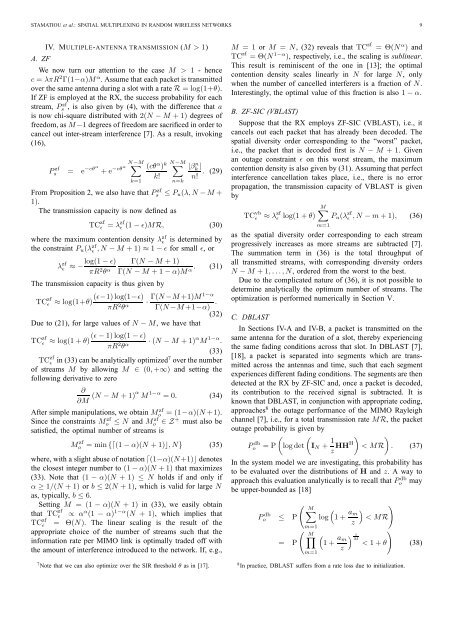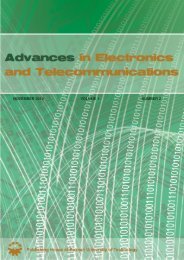channel - Advances in Electronics and Telecommunications
channel - Advances in Electronics and Telecommunications
channel - Advances in Electronics and Telecommunications
You also want an ePaper? Increase the reach of your titles
YUMPU automatically turns print PDFs into web optimized ePapers that Google loves.
STAMATIOU et al.: SPATIAL MULTIPLEXING IN RANDOM WIRELESS NETWORKS 9<br />
A. ZF<br />
IV. MULTIPLE-ANTENNA TRANSMISSION (M > 1)<br />
We now turn our attention to the case M > 1 - hence<br />
c = λπR 2 Γ(1−α)M α . Assume that each packet is transmitted<br />
over the same antenna dur<strong>in</strong>g a slot with a rate R = log(1+θ).<br />
If ZF is employed at the RX, the success probability for each<br />
stream, P zf<br />
s , is also given by (4), with the difference that a<br />
is now chi-square distributed with 2(N − M + 1) degrees of<br />
freedom, as M −1 degrees of freedom are sacrificed <strong>in</strong> order to<br />
cancel out <strong>in</strong>ter-stream <strong>in</strong>terference [7]. As a result, <strong>in</strong>vok<strong>in</strong>g<br />
(16),<br />
P zf<br />
s<br />
= e−cθα<br />
+ e −cθα<br />
N−M �<br />
k=1<br />
(cθ α ) k<br />
k!<br />
N−M �<br />
n=k<br />
|βn k |<br />
. (29)<br />
n!<br />
From Proposition 2, we also have that P zf<br />
s ≤ Pu(λ, N − M +<br />
1).<br />
The transmission capacity is now def<strong>in</strong>ed as<br />
TC zf<br />
ǫ<br />
= λzf ǫ (1 − ǫ)MR, (30)<br />
where the maximum contention density λzf ǫ is determ<strong>in</strong>ed by<br />
the constra<strong>in</strong>t Pu(λzf ǫ , N − M + 1) ≈ 1 − ǫ for small ǫ, or<br />
λ zf<br />
ǫ<br />
≈ − log(1 − ǫ)<br />
πR 2 θ α<br />
Γ(N − M + 1)<br />
The transmission capacity is thus given by<br />
. (31)<br />
Γ(N − M + 1 − α)M α<br />
TC zf<br />
(ǫ−1) log(1−ǫ)<br />
ǫ ≈ log(1+θ)<br />
πR2θα · Γ(N −M +1)M 1−α<br />
Γ(N −M +1−α) .<br />
(32)<br />
Due to (21), for large values of N − M, we have that<br />
TC zf<br />
(ǫ − 1) log(1 − ǫ)<br />
ǫ ≈ log(1 + θ)<br />
πR2θα · (N − M + 1) α M 1−α .<br />
(33)<br />
TC zf<br />
ǫ <strong>in</strong> (33) can be analytically optimized7 over the number<br />
of streams M by allow<strong>in</strong>g M ∈ (0, +∞) <strong>and</strong> sett<strong>in</strong>g the<br />
follow<strong>in</strong>g derivative to zero<br />
∂<br />
∂M (N − M + 1)α M 1−α = 0. (34)<br />
After simple manipulations, we obta<strong>in</strong> M zf<br />
o = (1−α)(N +1).<br />
S<strong>in</strong>ce the constra<strong>in</strong>ts M zf<br />
o<br />
satisfied, the optimal number of streams is<br />
M zf<br />
o<br />
≤ N <strong>and</strong> M zf<br />
o ∈ Z+ must also be<br />
= m<strong>in</strong> {⌈(1 − α)(N + 1)⌋, N} (35)<br />
where, with a slight abuse of notation ⌈(1−α)(N +1)⌋ denotes<br />
the closest <strong>in</strong>teger number to (1 − α)(N + 1) that maximizes<br />
(33). Note that (1 − α)(N + 1) ≤ N holds if <strong>and</strong> only if<br />
α ≥ 1/(N + 1) or b ≤ 2(N + 1), which is valid for large N<br />
as, typically, b ≤ 6.<br />
Sett<strong>in</strong>g M = (1 − α)(N + 1) <strong>in</strong> (33), we easily obta<strong>in</strong><br />
that TC zf<br />
ǫ ∝ αα (1 − α) 1−α (N + 1), which implies that<br />
TC zf<br />
ǫ = Θ(N). The l<strong>in</strong>ear scal<strong>in</strong>g is the result of the<br />
appropriate choice of the number of streams such that the<br />
<strong>in</strong>formation rate per MIMO l<strong>in</strong>k is optimally traded off with<br />
the amount of <strong>in</strong>terference <strong>in</strong>troduced to the network. If, e.g.,<br />
7 Note that we can also optimize over the SIR threshold θ as <strong>in</strong> [17].<br />
M = 1 or M = N, (32) reveals that TC zf = Θ(N α ) <strong>and</strong><br />
TC zf = Θ(N 1−α ), respectively, i.e., the scal<strong>in</strong>g is subl<strong>in</strong>ear.<br />
This result is rem<strong>in</strong>iscent of the one <strong>in</strong> [13]; the optimal<br />
contention density scales l<strong>in</strong>early <strong>in</strong> N for large N, only<br />
when the number of cancelled <strong>in</strong>terferers is a fraction of N.<br />
Interest<strong>in</strong>gly, the optimal value of this fraction is also 1 − α.<br />
B. ZF-SIC (VBLAST)<br />
Suppose that the RX employs ZF-SIC (VBLAST), i.e., it<br />
cancels out each packet that has already been decoded. The<br />
spatial diversity order correspond<strong>in</strong>g to the “worst” packet,<br />
i.e., the packet that is decoded first is N − M + 1. Given<br />
an outage constra<strong>in</strong>t ǫ on this worst stream, the maximum<br />
contention density is also given by (31). Assum<strong>in</strong>g that perfect<br />
<strong>in</strong>terference cancellation takes place, i.e., there is no error<br />
propagation, the transmission capacity of VBLAST is given<br />
by<br />
TC vb<br />
ǫ ≈ λ zf<br />
ǫ log(1 + θ)<br />
M�<br />
m=1<br />
Pu(λ zf<br />
ǫ , N − m + 1), (36)<br />
as the spatial diversity order correspond<strong>in</strong>g to each stream<br />
progressively <strong>in</strong>creases as more streams are subtracted [7].<br />
The summation term <strong>in</strong> (36) is the total throughput of<br />
all transmitted streams, with correspond<strong>in</strong>g diversity orders<br />
N − M + 1, . . . , N, ordered from the worst to the best.<br />
Due to the complicated nature of (36), it is not possible to<br />
determ<strong>in</strong>e analytically the optimum number of streams. The<br />
optimization is performed numerically <strong>in</strong> Section V.<br />
C. DBLAST<br />
In Sections IV-A <strong>and</strong> IV-B, a packet is transmitted on the<br />
same antenna for the duration of a slot, thereby experienc<strong>in</strong>g<br />
the same fad<strong>in</strong>g conditions across that slot. In DBLAST [7],<br />
[18], a packet is separated <strong>in</strong>to segments which are transmitted<br />
across the antennas <strong>and</strong> time, such that each segment<br />
experiences different fad<strong>in</strong>g conditions. The segments are then<br />
detected at the RX by ZF-SIC <strong>and</strong>, once a packet is decoded,<br />
its contribution to the received signal is subtracted. It is<br />
known that DBLAST, <strong>in</strong> conjunction with appropriate cod<strong>in</strong>g,<br />
approaches 8 the outage performance of the MIMO Rayleigh<br />
<strong>channel</strong> [7], i.e., for a total transmission rate MR, the packet<br />
outage probability is given by<br />
P db<br />
� �<br />
o = P log det IN + 1<br />
z HHH<br />
�<br />
�<br />
< MR . (37)<br />
In the system model we are <strong>in</strong>vestigat<strong>in</strong>g, this probability has<br />
to be evaluated over the distributions of H <strong>and</strong> z. A way to<br />
approach this evaluation analytically is to recall that P db<br />
o may<br />
be upper-bounded as [18]<br />
P db<br />
�<br />
M� �<br />
o ≤ P log 1 +<br />
m=1<br />
am<br />
�<br />
�<br />
< MR<br />
z<br />
�<br />
M� �<br />
= P 1 + am<br />
�<br />
� 1<br />
M<br />
< 1 + θ<br />
z<br />
m=1<br />
8 In practice, DBLAST suffers from a rate loss due to <strong>in</strong>itialization.<br />
(38)







